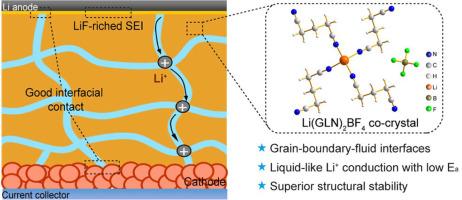固态电池用具有晶界流动性的低熔点固体电解质
IF 20.2
1区 材料科学
Q1 CHEMISTRY, PHYSICAL
引用次数: 0
摘要
作为固态电池的关键部件,固体电解质的需求日益迫切。然而,SE和电极之间有限的物理接触引起了界面问题,导致电荷传输中断和界面处的显着电阻。在这项研究中,我们提出了一种共晶SE, Li(GLN)2BF4 (GLN,戊二腈),它具有传统陶瓷所没有的特性,特别是60°C的低熔点和晶界流动性。这些特性有助于在没有外部压力的情况下进行紧密的界面接触,从而为高性能ssb实现类似液体的Li+传导。因此,该SE在30°C时的离子电导率为1.43 × 10−4 S cm−1,锂离子转移数为0.74。重要的是,原位广角x射线散射证明了它在电化学循环过程中具有优越的结构稳定性。得益于这些特性,Li||锂对称电池可以稳定运行600小时,而Li||LiFePO4电池在室温和零外部压力下运行400次后仍能保持其初始容量的92.3%。与陶瓷电解质相比,这项工作为探索可同时实现界面相容性和化学稳定性的共晶物质铺平了新的途径。本文章由计算机程序翻译,如有差异,请以英文原文为准。


A low-melting solid electrolyte with grain-boundary fluidity for solid-state batteries
Solid electrolytes (SEs) are urgently needed as key components of solid-state batteries (SSBs). However, the limited physical contact between the SE and electrode gives rise to interfacial issues, causing interrupted charge transport and significant resistance at the interface. In this study, we propose a co-crystalline SE, Li(GLN)2BF4 (GLN, glutaronitrile), exhibiting a combination of properties not found in conventional ceramics, notably a low melting point of 60 °C and its grain-boundary fluidity. These features facilitate intimate interfacial contact without external pressure, thereby enabling liquid-like Li+ conduction for high-performance SSBs. Consequently, this SE exhibits an ionic conductivity of 1.43 × 10−4 S cm−1 at 30 °C and a lithium-ion transference number of 0.74. Importantly, it exhibits superior structural stability during electrochemical cycling as evidenced by in-situ wide-angle X-ray scattering. Benefitting from these properties, Li||Li symmetric cells exhibit stable operation for 600 h, while Li||LiFePO4 cells retain 92.3 % of its initial capacity after 400 cycles, all operating at room temperature and under zero externally applied pressure. This work paves new avenues for exploring co-crystalline substances that can concurrently achieve interfacial compatibility and chemical stability, in contrast to ceramic electrolytes.
求助全文
通过发布文献求助,成功后即可免费获取论文全文。
去求助
来源期刊

Energy Storage Materials
Materials Science-General Materials Science
CiteScore
33.00
自引率
5.90%
发文量
652
审稿时长
27 days
期刊介绍:
Energy Storage Materials is a global interdisciplinary journal dedicated to sharing scientific and technological advancements in materials and devices for advanced energy storage and related energy conversion, such as in metal-O2 batteries. The journal features comprehensive research articles, including full papers and short communications, as well as authoritative feature articles and reviews by leading experts in the field.
Energy Storage Materials covers a wide range of topics, including the synthesis, fabrication, structure, properties, performance, and technological applications of energy storage materials. Additionally, the journal explores strategies, policies, and developments in the field of energy storage materials and devices for sustainable energy.
Published papers are selected based on their scientific and technological significance, their ability to provide valuable new knowledge, and their relevance to the international research community.
 求助内容:
求助内容: 应助结果提醒方式:
应助结果提醒方式:


